Hitachi Deskstar 7K1000 in RAID 0: Is Two Terabytes really better than One?
by Gary Key on April 19, 2007 12:15 AM EST- Posted in
- Storage
iPeak Business Application Tests
Our iPeak Winstone benchmarks offer a glimpse into how well our hard disk drives will handle general office applications, media encoding, and graphics manipulation. While the business applications that are being tested tend to be more CPU bound at times, the performance of the hard drive can and will make a difference in the more disk intensive video and graphics applications where large media files are typically being edited.
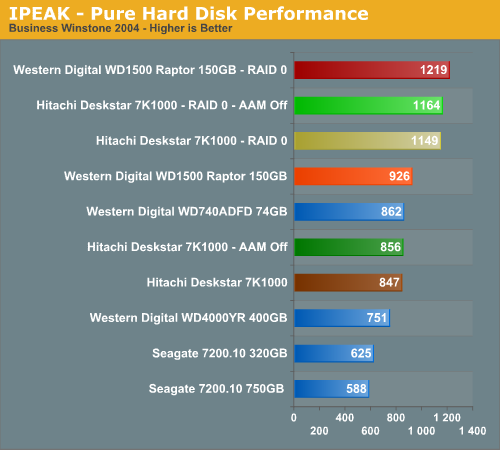
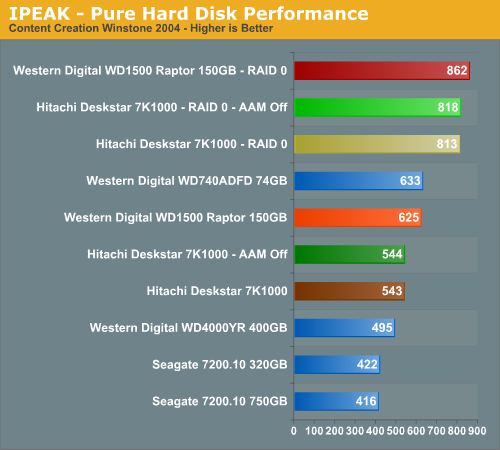
As expected the WD1500 Raptor drives finish at the top in our business application tests as its 10k RPM spindle speed and optimized cache play an important role in its ability to sustain high transfer rates, especially in the Content Creation benchmark where transfer block sizes are significantly larger and more random than in the Business application benchmark. This is true with either a single drive or RAID 0 setup although we see the 7K1000 trailing the WD1500 by less the 5% in these tests. While RAID 0 has the theoretical capability to improve throughput by up to 100% before system overhead, we only see a 31% to 35% improvements in these pure hard disk benchmarks.
iPeak General Task Tests
The iPeak based General Task benchmarks are designed to replicate utility based application tasks that typically are disk intensive and represent common programs utilized on the majority of personal computers. While the WinRAR program is very CPU intensive it will typically stress the storage system in short bursts. Our antivirus benchmark will stress the storage system with continual reads and sporadic write requests while the defragmentation process is split between continual read and write requests.
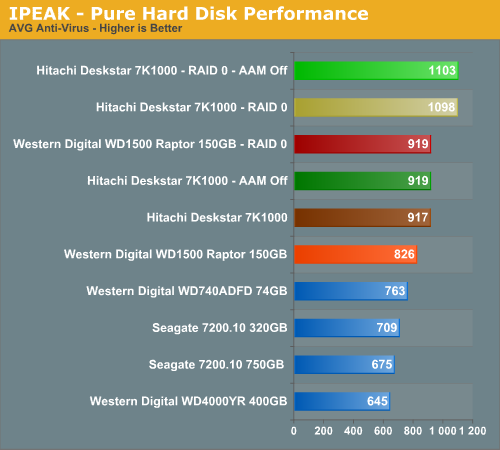
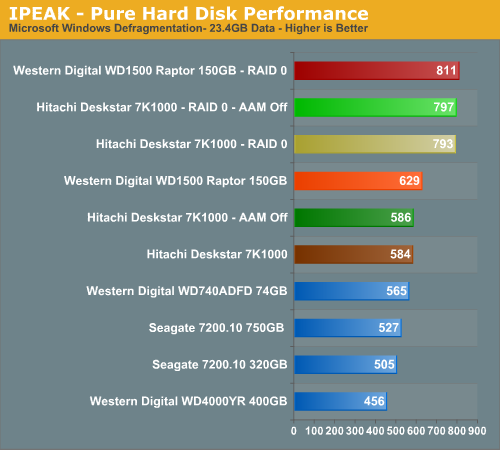
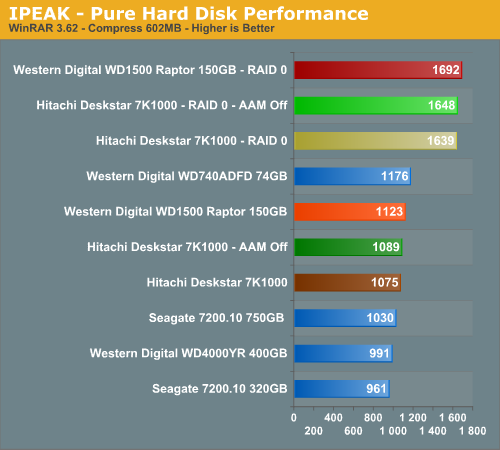
The 7K1000 performs extremely well in the Anti-Virus and Defragmentation test where its 32 MB cache benefits read operations with results that mirror the PCMark 2005 tests. This holds true with the RAID 0 configuration although we only see a 20% improvement in the AVG test results. Also of interest is that in the AVG test we see the Raptor RAID 0 setup score the same as the single drive 7K1000 configuration.
The Raptor holds a small advantage in the Windows defragmentation test in both the RAID 0 and single drive results. The rotational speed of the Raptors just cannot be beat in this test, but the 7K1000s score extremely well due to their cache size.
This is especially true in the WinRAR tests where the rotational and access speeds of the Raptors outperformed the 7K1000 setups in both configurations. In this test, write speeds are very important and we see the RAID 0 setups scoring around 50% better, though we expected better performance based upon the PCMark05 results. However, keep these pure performance results in mind as they will not be repeated in our actual WinRAR tests.
Our iPeak Winstone benchmarks offer a glimpse into how well our hard disk drives will handle general office applications, media encoding, and graphics manipulation. While the business applications that are being tested tend to be more CPU bound at times, the performance of the hard drive can and will make a difference in the more disk intensive video and graphics applications where large media files are typically being edited.


As expected the WD1500 Raptor drives finish at the top in our business application tests as its 10k RPM spindle speed and optimized cache play an important role in its ability to sustain high transfer rates, especially in the Content Creation benchmark where transfer block sizes are significantly larger and more random than in the Business application benchmark. This is true with either a single drive or RAID 0 setup although we see the 7K1000 trailing the WD1500 by less the 5% in these tests. While RAID 0 has the theoretical capability to improve throughput by up to 100% before system overhead, we only see a 31% to 35% improvements in these pure hard disk benchmarks.
iPeak General Task Tests
The iPeak based General Task benchmarks are designed to replicate utility based application tasks that typically are disk intensive and represent common programs utilized on the majority of personal computers. While the WinRAR program is very CPU intensive it will typically stress the storage system in short bursts. Our antivirus benchmark will stress the storage system with continual reads and sporadic write requests while the defragmentation process is split between continual read and write requests.



The 7K1000 performs extremely well in the Anti-Virus and Defragmentation test where its 32 MB cache benefits read operations with results that mirror the PCMark 2005 tests. This holds true with the RAID 0 configuration although we only see a 20% improvement in the AVG test results. Also of interest is that in the AVG test we see the Raptor RAID 0 setup score the same as the single drive 7K1000 configuration.
The Raptor holds a small advantage in the Windows defragmentation test in both the RAID 0 and single drive results. The rotational speed of the Raptors just cannot be beat in this test, but the 7K1000s score extremely well due to their cache size.
This is especially true in the WinRAR tests where the rotational and access speeds of the Raptors outperformed the 7K1000 setups in both configurations. In this test, write speeds are very important and we see the RAID 0 setups scoring around 50% better, though we expected better performance based upon the PCMark05 results. However, keep these pure performance results in mind as they will not be repeated in our actual WinRAR tests.










48 Comments
View All Comments
photoguy99 - Thursday, April 19, 2007 - link
You have tested XP 32-bit which uses the "ScsiPort" storage system.This artificially limits results using Raid.
Vista 32, Vista x64, and XP x64 all use the "StorPort" storage system, which is much faster and doesn't limit Raid results.
You could add 4 or 8 drives in Raid 0 and your transfer rates would not change much.
This should really be part of the discussion for the article.
yyrkoon - Thursday, April 19, 2007 - link
Funny that, last time I personally did a dirrect comparrison of a 3xRAID0 array in Vista, it was 30-40MB/s slower comparred to the same array in XP Pro.Nothing changed, only the OS.
photoguy99 - Thursday, April 19, 2007 - link
Perhaps in your case the Vista driver was not as optimized as the XP driver or was not using storport.However, it is absolutely invalid to benchmark raid performance on XP 32-bit if your goal is to test hardware rather than OS specific results.
Microsoft reference:
http://msdn2.microsoft.com/en-us/library/ms803198....">http://msdn2.microsoft.com/en-us/library/ms803198....
AllanLim - Thursday, April 19, 2007 - link
http://kakaku.com/item/05300415786/">http://kakaku.com/item/05300415786/Along with every other pc component, this probably comes at 20-30% premium compared to Stateside when it becomes available, but at least you can but it here.
Myrandex - Thursday, April 19, 2007 - link
Two 250GB drives in Raid 0. I dunno, I still feel that it helps with some load times on large maps on games and large numbers of file transfers at once, but I could be full of it. I do keep an off disk backup though that is pretty current.Jason
Sunrise089 - Thursday, April 19, 2007 - link
Sorry to double-post, but the end of the article says:" As stated in both articles, we believe leaving AAM and NCQ turned provides the best user experience with this drive."
I think there should be an "on" or "off" after "turned".
Sunrise089 - Thursday, April 19, 2007 - link
I have a long-running arguement with another PC enthusiest about the relative merit of RAID 0. Some people just cannot get it through their heads that no matter how great the idea sounds, the performance just isn't justified by the cost. At all. With video card price/performance scaling perfectly, and CPU and memory scaling at least OK, it's insane to spend hundreds of dollars on a second hard drive and gain a few percentage points in real-world tests. Thanks Anandtech for keeping the real-world focus of these articles.mesyn191 - Saturday, April 21, 2007 - link
Depends how its done...These software RAID controllers (yes NVRAID, Intel Matrix RAID, Silicon Image 3112/4 etc, Promise, Highpoint are all software RAID controllers that often act more like storage subsystem DE-celerators and often slow things down...) that Anandtech keeps using to demonstrate the pointlessness of RAID 0 really only prove how crappy software RAID controllers are. If you use a "real" enterprise class RAID controller that has a dedicated CPU and significant cache you'll see some real world performance improvements, even with doing things like loading games which is a far from ideal work load for RAID 0. The problem is most of these "real" RAID controllers tend to cost ~$300, and that is for a cheap one, high end versions can easily cost thousands of dollars and most people don't want to spend that much on storage. Most of these enterprise class controllers also tend to have issues working with desktop motherboards, they're really meant for use in server motherboards and so they won't even boot up properly in alot of them, just read up on all the issues people tend to have getting the Areca 1210 (probably the most commonly used enterprise class RAID card in the enthusiast PC crowd) PCIe RAID cards working in commodity consumer grade motherboards.
Of course another nice thing about those enterprise class RAID controllers is most of them support multiple levels of RAID at the same time, so you can have a RAID 0 set and a RAID 5 set on the same bunch of hard drives, providing you a good way to safe guard your data and get a performance benefit.
PenGun - Friday, April 20, 2007 - link
K .... maybe you can tell me how I'm gonna get a solid write of 150MB/sec any other way. My camera in HD SDI needs to move that much data.RAID 0 or perhaps RAID 5 (to be tested soon) is the only way. 4 Western Digital 500G drives is my way of handling that fire hose of data.
Oh go back to your games it really does not matter, it's just my problem right now. It is my desktop when it's full. It's easier to crunch the massive files in situ.
yyrkoon - Thursday, April 19, 2007 - link
Some people just can not seem to get it through their heads, that not everyone plays games, or surfs the web, on a home desktop PC. Video editing applications that require 65MB/s substained transfers rates, will require either a very fast disk, or two lesser drives striped.
Since most enterprise drives cost an arm and a leg, I think running RAID0 for this application, or something that NEEDS the throughput justifies the cost. Now, I personally DO run RAID0 on my home desktop, and I think it is more than justified, but I do not expect it to work wonders, and I definately know, it will not make my system boot faster, will not make a First Person Shooter faster (except, perhaps level load times, which is pretty much moot).
Now, Imagine spending 2x $400 for RAID1 . . . that is what I call a waste of money, although, with these hitachi drives, who knows how reliable they are. The point here, being, you can not tell anyone what they need, or want in a desktop, because you really have not a clue what they really need / want. This being said, RAID0 for most people probably is overkill.